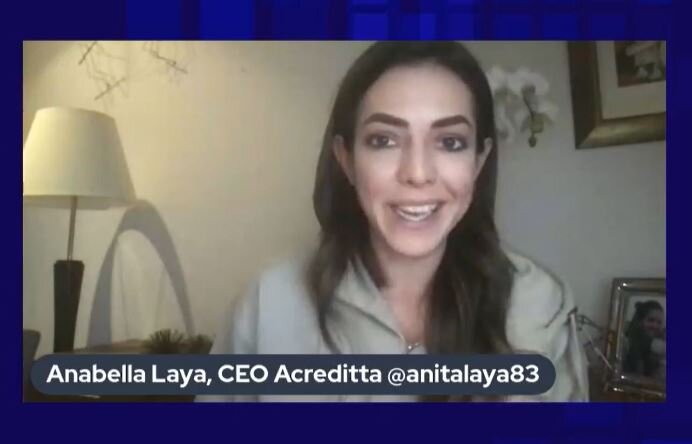“Degrees and diplomas comprise an old format that does not provide detailed information on what a person knows how to do or what a person has learned.”
Where do you store the certificates of your professional or academic achievements that you earned throughout your career or school life? On the wall of your house, your computer, on LinkedIn, or do you even remember where they were stored? It is a reflection that Anabella Laya, CEO of ACREDITTA, invites us to make in the Observatory webinar of the Institute for the Future of Education at Tecnológico de Monterrey. In this session, Anabella explains what digital credentials are and their relationship with blockchain technology for education.
For many years, we have used degrees and diplomas to demonstrate our achievements or acquired skills; however, these comprise an old format that does not provide detailed information about what a person knows how to do or what they learned. For example, the entrepreneurial ventures carried out, the anecdotal experiences, the challenges faced by the team, goals, etc. Moreover, traditional diplomas and certificates can be unreliable because they are easily replicated with design software and insecure. So, there is a need for reliable and standardized instruments that provide a granular and verifiable record of a person’s knowledge and skills acquisitions in formal and non-formal environments.
“Higher education leaders must adapt to new formats such as digital credentials to certify the knowledge or skills that students acquire.”
What are digital credentials?
They are evidence or graphical representations of achievement, knowledge, competencies, or skills. Digital credentials are distinguished from traditional paper titles by three principal characteristics:
1. They are portable. It means that we can take the credentials anywhere since they “live” in the digital world.
2. They are verifiable online in real-time. It means that anyone can verify credentials. It’s different from a PDF file, subject to anyone falsifying it if a security code does not protect it.
3. They contain more information. Digital credentials provide more information than we might find in a PDF because the metadata amplifies information about the achievement. We find information such as:
-
Description of the learning experience. We can know what a person learned in more profound detail.
-
Specific skills. For example, conflict resolution, verbal communication, influence, performance in work teams, etc. It is the kind of information that recruiters and human resource leaders request to have specific information about the professional skills and know-how.
-
Criteria for awarding digital recognitions. These are criteria for the ones who award the digital insignias; they specify, for example, what the students had to do for a specific achievement. Examples include developing a project, publishing a paper, and performing an assessment, etc.
-
Evidence. Anyone can consult the digital products that provide evidence of the learning process through a link to the product, project, or work performed by a student, teacher, or professional.
-
They are easily socializable. Sharing credentials on social networks is a way to add to our digital identity by making our achievements and professional or academic recognitions visible.
What is blockchain, and how does it relate to digital credentialing?
Blockchain is a methodology that functions through a chain of blocks. To describe it, Anabella uses the analogy of a massive, public, and decentralized “notary,” enabling any information that must be verified or authenticated to be leveraged with blockchain technology. Blockchain technology supports the issuance of these digital insignias. It has crucial uses in education because it provides security by shielding degrees and certifications registered on this platform. At the same time, everything is verifiable in real-time and accepted anywhere in the world.
When is blockchain used?
-
When involving high-value credentials, as defined by the institution.
-
When multiple events in our lives are required to be verified.
-
When verification free of geography and borders is required (a global standard).
-
When owning “my achievements” becomes essential, given that it is part of our digital identity.
Finally, Anabella Laya shares that new players have entered each part of the student life cycle, such as companies and startups contributing their services, knowledge, and experiences to institutional processes. These include student recruitment, admissions, curriculum design, the student experience, course contents, evaluations, the certifications of achievement, and lifelong learning. She invites us to reflect and think about working with these companies to continue innovating in educational technology, always looking to students’ success.
If you did not have the opportunity to join us live on this webinar, you can view the complete video here.
Anabella Laya Vizcaíno (anitalaya@acreditta.com) is the CEO and co-founder of ACREDITTA. In 2018, she introduced digital credentialing in Latin America as a new standard for skills recognition. She has a degree in Social Communications from the UCAB with a specialization in Public Relations and Advertising. She has certifications in the digital marketing industry, design thinking, blockchain essentials, and artificial intelligence.
If your native language is not Spanish, you can activate YouTube’s subtitled instant translator for the content in this article. To activate this option, select the Subtitles option on YouTube (the Subtitles in Spanish will appear), then select Settings ->Subtitles -> Translate automatically, and select the language you prefer.
Translation by Daniel Wetta.
This article from Observatory of the Institute for the Future of Education may be shared under the terms of the license CC BY-NC-SA 4.0 
)
)


)